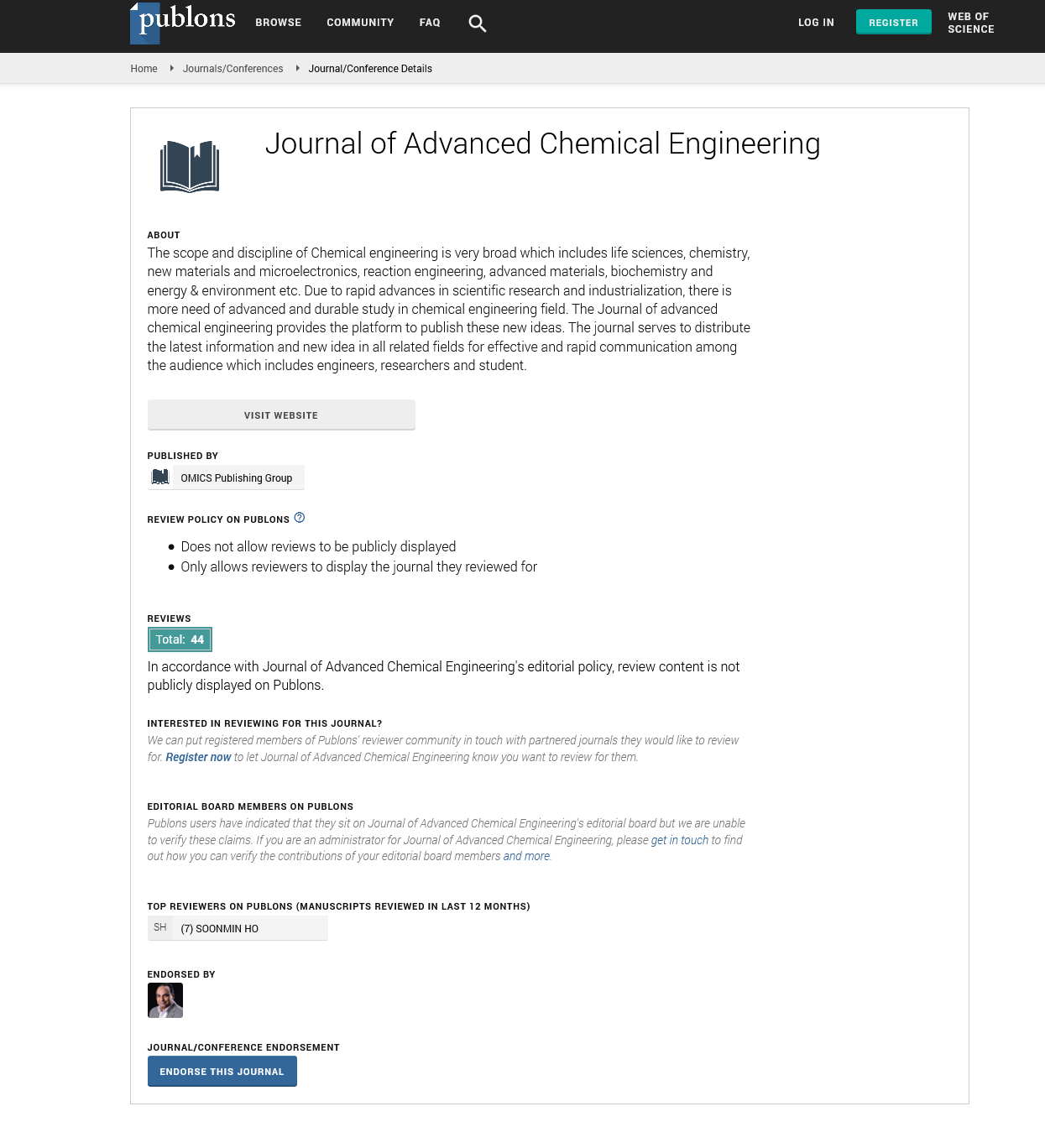Indexed In
- Open J Gate
- Genamics JournalSeek
- Smithers Rapra
- RefSeek
- Directory of Research Journal Indexing (DRJI)
- Hamdard University
- EBSCO A-Z
- OCLC- WorldCat
- Scholarsteer
- Publons
- Geneva Foundation for Medical Education and Research
- Google Scholar
Useful Links
Share This Page
Journal Flyer

Open Access Journals
- Agri and Aquaculture
- Biochemistry
- Bioinformatics & Systems Biology
- Business & Management
- Chemistry
- Clinical Sciences
- Engineering
- Food & Nutrition
- General Science
- Genetics & Molecular Biology
- Immunology & Microbiology
- Medical Sciences
- Neuroscience & Psychology
- Nursing & Health Care
- Pharmaceutical Sciences
Commentary - (2025) Volume 15, Issue 2
Nanofluids and Their Expanding Role in Heat Transfer Applications
Kavita Mehra*Received: 30-May-2025, Manuscript No. ACE-25-29805; Editor assigned: 02-Jun-2025, Pre QC No. ACE-25-29805 (PQ); Reviewed: 16-Jun-2025, QC No. ACE-25-29805; Revised: 23-Jun-2025, Manuscript No. ACE-25-29805 (R); Published: 30-Jun-2025, DOI: 10.35248/2090-4568.25.15.366
Description
Nanofluids, engineered colloidal suspensions of nanoparticles in conventional heat transfer fluids, have emerged as a groundbreaking innovation in chemical engineering. Their unique ability to enhance thermal conductivity and heat transfer performance has positioned them as vital tools in applications ranging from power generation and electronics cooling to chemical process industries and renewable energy systems. The exploration of nanofluids represents a significant step forward in overcoming the limitations of traditional fluids like water, ethylene glycol, and mineral oils, which often exhibit inadequate thermal properties for modern technological demands.
The concept of nanofluids originated in the late 1990s, when researchers began experimenting with dispersing metallic and non-metallic nanoparticles into base fluids to improve their thermal performance. Nanoparticles such as aluminum oxide, copper oxide, titanium dioxide, and carbon nanotubes are among the most widely studied due to their high intrinsic thermal conductivities. When properly dispersed, these particles create enhanced thermal pathways within the fluid, facilitating faster and more efficient heat transfer. Unlike conventional solid-liquid suspensions, nanofluids maintain stability, avoid clogging in flow systems, and provide improved performance even at low particle concentrations.
The mechanisms driving nanofluid performance are complex and continue to be the subject of extensive research. Brownian motion, liquid layering around nanoparticles, micro-convection, and changes in effective viscosity all contribute to the observed enhancements in thermal conductivity and convective heat transfer. The small size of nanoparticles ensures a large surface area-to-volume ratio, enabling greater interaction between particles and fluid molecules. However, the challenge lies in maintaining uniform dispersion and preventing aggregation, as clumping reduces performance and stability. Surface functionalization and the use of surfactants have been developed to address these issues, ensuring consistent suspension and longterm reliability of nanofluids in practical applications.
Applications of nanofluids are diverse and expanding. In the energy sector, nanofluids are being explored for improving the efficiency of solar thermal collectors by enhancing the absorption and transfer of solar energy. They are also employed in heat exchangers, where improved thermal performance translates into more compact designs and reduced energy consumption. In nuclear reactors, nanofluids hold potential for improving cooling efficiency and safety margins, critical factors in maintaining operational stability. The electronics industry has embraced nanofluids for cooling microprocessors and high-performance computing systems, where managing heat is essential for preventing device failure and extending lifespan. Automotive industries are investigating nanofluids as coolants to enhance engine performance and fuel efficiency.
Despite these promising applications, challenges remain in scaling up nanofluid production and ensuring cost-effectiveness. The synthesis of nanoparticles often involves energy-intensive processes and expensive raw materials, raising concerns about commercial viability. Furthermore, questions about environmental and health impacts associated with nanoparticle release must be addressed. Researchers are exploring green synthesis methods, such as plant-based and microbial routes for nanoparticle production, which align with sustainability goals and reduce environmental risks.
The role of computational modeling in advancing nanofluid research cannot be overstated. Molecular dynamics simulations, computational fluid dynamics, and machine learning algorithms are increasingly used to predict nanofluid behavior, optimize compositions, and design systems for real-world applications. These digital tools accelerate innovation by reducing reliance on trial-and-error experiments, thereby saving time and resources.
Looking forward, hybrid nanofluids, which combine two or more types of nanoparticles, are gaining attention for their ability to harness synergistic effects and achieve superior performance. For instance, combining metallic nanoparticles with carbon-based materials can enhance both thermal conductivity and stability. Research into phase-change nanofluids, which integrate nanoparticles into phase-change materials, is also expanding, with applications in thermal energy storage and management.
In conclusion, nanofluids represent a transformative advance in chemical engineering, bridging fundamental science with practical applications. By enhancing heat transfer in critical systems, they contribute to improved energy efficiency, reduced environmental impact, and the advancement of high-tech industries. While challenges remain in cost, scalability, and safety, the future of nanofluids looks promising as researchers continue to innovate and expand their applications. The integration of nanotechnology, green synthesis, and computational design will likely ensure that nanofluids play an increasingly central role in addressing the heat transfer challenges of tomorrow.
Citation: Mehra K (2025). Nanofluids and their Expanding Role in Heat Transfer Applications. Adv Chem Eng. 15:366.
Copyright: © 2025 Mehra K. This is an open-access article distributed under the terms of the Creative Commons Attribution License, which permits unrestricted use, distribution, and reproduction in any medium, provided the original author and source are credited.

